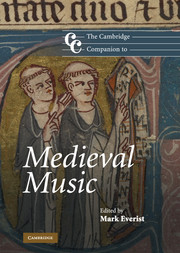3 - Early polyphony to circa 1200
from Part I - Repertory, styles and techniques
Published online by Cambridge University Press: 28 September 2011
Summary
Some surface aspects of musical art for the adornment of ecclesiastical songs have been outlined here.
Here begin mellifluous songs of organum upon the sweetest praises of heaven.
But in whatever way it is done . . . in producing diaphony the precentor must harmoniously sing in praise of the creator.
As the above quotations suggest, early Western polyphony was broadly viewed as a way of elaborating and adorning monophonic chant, was heard as beautiful and sweet in sound, and was considered an appropriate means of religious praise. The close connection with religious worship is not surprising, given that the extant written record – both theoretical descriptions and musical notations – of polyphony stems from literate ecclesiastical and monastic spheres. But that record is decidedly incomplete and radically discontinuous. This is because early polyphony was ‘produced’ or ‘made’, not ‘composed’ in the present-day sense of ‘composition’: it was in the first instance sounded, not notated. Polyphony arose and continued as a performance practice, a way of elaborating a known monophonic melody with a second line that was produced according to accepted conventions. Polyphonic singing enhanced worship through amplification of monophonic song. The earliest treatise to describe the phenomenon, the Musica Enchiriadis from circa 850, treats it as a familiar extempore practice, one known under two names: diaphony and organum. These alternative terms (the latter characterized as ‘customary’), refer to different core facets of polyphony: diaphonia to the dual sounds produced between two voices, the sounding-apart of the pair; organum to the perfect consonances or symphoniae (fourth, fifth, octave) that controlled the relationship between voices.
- Type
- Chapter
- Information
- The Cambridge Companion to Medieval Music , pp. 46 - 66Publisher: Cambridge University PressPrint publication year: 2011
- 2
- Cited by



